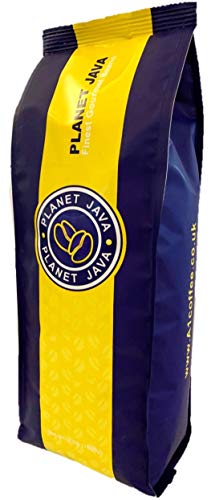Starbucks Coffee Beans 1kg
Starbucks was a cozy cafe situated in Seattle, Washington before it became famous for its peppermint Mochas and red holiday cups. Starbucks' founders were focused on selling whole beans of coffee but did not see the potential in espresso drinks.
Schultz changed everything. He was determined to show off his roasting and blending skills.

Origin
Starbucks coffee beans have a long, winding journey before they reach your cup. Coffee is cultivated almost exclusively in the Coffee Belt. This area is located all over the world between the Tropics Cancer and Capricorn. The taste of coffee beans is influenced by the climate, soil, and the culture of the region. Starbucks sources its coffee from more than 30 countries around the world.
Starbucks coffees are mostly produced in Latin America, Africa and Asia-Pacific. These regions are famous for their full-flavor, balanced taste and of body and acidity. Starbucks also sources coffee from St. Helena in the South Atlantic Ocean, a volcanic tropical paradise.
Starbucks coffee beans are roasted to perfection for an incredibly smooth and delicious taste. The coffee beans are then ground into a fine powder which is ready to be brewed. The powder is then mixed with water and then poured into a cup to create an espresso drink that is delicious. The result is a cup full of flavor and energy.
While the majority of Starbucks coffees are made from blends of various beans, there are a variety of varieties of single-origin coffees available at the stores of the chain. Single-origin Starbucks coffees are available in a variety of flavors like chocolatey and fruity, sweet and nutty. Some single-origin beans are certified organic.
Starbucks's beans are sourced from all over the world however, they must meet certain standards to qualify as special. Specialty coffee was first used in the 1980s, when roasters and cafes began to experiment with lighter roasting techniques and manual methods. Starbucks hasn't yet begun making its coffee sourcing decisions based on these standards, but it has since adopted them.
In addition to ensuring its beans are grown in a responsible way, Starbucks works to improve the lives of the people who cultivate their coffee. It pays its coffee farmers a premium over the market price and allows them to invest in their communities. It also promotes sustainability and works to reduce waste. This has led to the creation of new methods for growing coffee and practices that safeguard the environment.
Roast
Starbucks roasts beans in large quantities and purchases beans in bulk. The roasting process lasts between 10 to 15 minutes, and the resultant dark roasted beans. The dark roasted beans give a rich flavor and have full body. The beans are ground and then sent to stores and supermarkets in the form of coffee grind. The coffee that is ground is bitter and is not ideal to make the perfect cup. This is why a lot of people add a lot of sugar, cream, milk, flavorings whipping cream, and other ingredients to their coffee. This won't mask the bitterness of the coffee, but it does make the drink more appealing.
When the beans are first placed into the roaster they begin to steam due their internal moisture. Then comes the "first crack", an audible sound that indicates when the actual roasting has begun. At this point the sugars begin caramelize and bound-up water escapes. In the same time the structure of the bean breaks down and the oils move outward from their little pockets. This stage is the point at which the majority of coffees are considered a city roast.
The roasted beans then cool and are then separated from any impurities or stones that have been removed from the roaster. They are then examined by hand before being packed to be sold. Some beans have a dark spot, which is known as the quaker. The beans did not change color or tasted burned. This is a typical phenomenon, but it does not suggest that the coffee is bad.
The beans are often roast in small batches that can be as small as 20 pounds. They are referred to as "micro-lots". This is because every cup will be roasted according to specifications developed by the Starbucks team of coffee masters. The team of coffee masters develops profiles that are used by all Starbucks(r) roasting facilities, around the globe. These profiles ensure that every cup of coffee brewed will be consistent, and has the same amount of body and flavour.
Flavor
Starbucks purchases their coffee directly from the farm where they were grown, in order to help improve quality and ensure an ethical source. For every kilogram of coffee beans sold, Starbucks plants a tree. The beans themselves aren't identified by their origins to show where they originate from however some of the blends are named - Veranda originates from Sumatra, Komodo Dragon from Indonesian and Anniversary is a blend of african and central american beans. The beans have a distinctive taste profile and create a smooth cup with a delicate blend of sweetness and smoothness. 1kg coffee beans price Coffeee unveils a symphony of flavors, leaving a lingering, pleasant taste on your palate.
Weight
The weight of starbucks beans 1kg is determined by the blend. A Starbucks House Blend, for instance, weighs 14 oz per pound. A pound of Espresso-roast beans at Walmart, however, weighs 16 oz. This is equivalent to a 67% price premium at Starbucks in comparison to Wal-Mart.
Starbucks' Pike Place Roast was named after Seattle's famous marketplace. Its light-medium roast provides balance, sweetness, and smoothness in every cup. This blend, which is made from beans from Latin America is perfect for Americano or espresso. This premium blend comes with a FlavorLock package for protection and flavor preservation. This is Starbucks their signature coffee. This is a great choice for those who love coffee! Made with 100 percent Arabica beans. This is a great present for Starbucks fans.
